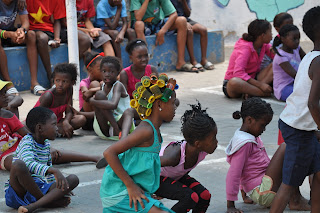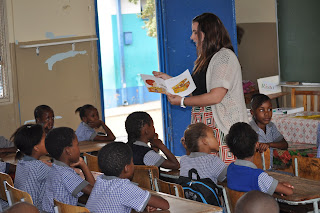 |
| The group with Tickey--our Sossusvlei guide and local driver |
Final Reflections
The program provides an incredibly rich learning
environment. Although students come to
be able to begin their student teaching in Katutura, the program provides
multiple opportunities experience Namibia.
This time we began on the Tjiramba farm, and although the students were
still adjusting to the time, the heat, and the food being immersed in an
authentic setting was a great way to begin the program. Students for the first time understand their learners’
summer experience of being “on the farm.”
Farms and homesteads are a way of life for many Namibians. Our students observed the self-sufficiency of
young children, children helping with daily chores because that’s the
expectations, and respect shown for elders by children and “elder” refers to
anyone that is older.
Our students participate in this program to begin their student teaching in Namibia. We have students at two primary schools (Grades K-7) and Pionier Boys School for "special" students ranging in ages from 13-21. These boys have not been successful in school and get an education and also learn a trade like welding and brick making.
A.I Steenkamp Pictures:
Teaching in Katutura is a challenge—the school and classroom
facilities are run down. The classrooms
are crowded—a class of 35 learners is small—most of our student teachers had
classes over 40 learners. Although
administrators at the school and university level always refer to best
practices, learners still spend an inordinate amount of copying information and
problems into their notebooks. It seems
the copying time often takes more time than instruction. However, we encourage our students to use the
strategies they have learned in our education program. They stay up late planning at night, the
develop activities that reinforce content from the books and they teach
strategies like talk to a partner or think in your head. We always hear from the cooperating teachers
how much they learn from our students.
One of my favorite stories from this year involves a management strategy
created by one of our students. She
refers to it as “Our Class’s Big 5.”
Namibia has their Big 5 which refers to the big 5 animals that are the
hardest to hunt (Elephant, lion, leopard, rhino, and buffalo). Our student recognized the context of her
learners and her Big 5 refers to how she counts down for attention—5 voices
off, 4 eyes forward…She made a poster and references the expectations when
counting down. After one week of her
teaching, her teacher who teaches most
afternoons (half the time he as left knowing he has a US student teacher in his
class, was reminding the learners of “Our Class’s Big 5, and using that as his
management strategy too.
St. Barnabas
 |
| Good bye High Fives |
(I am missing Pionier Boys School photos. They started academics late because of Athletics and we didn't get teaching photos)
Paula and I were able to observe every one of our student
teachers teaching. The timing worked
well this year—it seems most of our students are teaching the entire morning
before the break and are getting lots of teaching opportunities. Although there will always be ways for
improvement, our students have figured out ways to manage the large group of
learners, and are doing some really strong teaching. I observed one comprehension activity where
students were able to identify and describe story elements from a Read
Aloud. Our student had her learners
talking to each other before raising a hand to respond, and we talked about
ways to get more students participating in oral responses. I watched another pace her learning
activities, so the students transitioned from a comprehension activity, to a
singing review of letter sounds that included hand and body motions. All except 1 student was engaged and my
teacher noticed the lack of participation and pulled the student into the group
singing. Already in such a short time
the student teachers demonstrate confidence and have acquired “teacher
legs.” They have even talked about their
elevated levels of confidence in planning, management, and teaching. They have set themselves nicely for the next
month. Not all days will be great,
but they know how to support each other,
and they have a resource (Mary Beth) who has fabulous teacher skills
herself. Mary Beth (Director of the
after school program) will be eating Wednesday dinners with them, and we have
encouraged them to rely on her when they have questions because of her vast
experience teaching kids from Katutura.
BNC snapshots
 |
| Mary Beth training our students |
 |
| Before school started, ready for lunch |
Some other musings....
Home has very different meanings for Namibians. I have
thought about the idea of home on this trip because home has such varied
meanings for the people I interacted with during the month.
For Edwin, home is the farm and Windhoek is where he lives
and works. For Emmy his wife, their new
house is more like home. At the old
house there were always family members around, and now Emmy mostly has just her
children at home, although there are always family members that pop in, but the
home feels much calmer. Emmy has made
this place a home for her family. I
wonder what her children, who did not grow up on the farm will consider home.
For many young adults Katutura is home. In the 1970’s many of their parents were
forced to relocate to Katutura (means the place we will not settle), but they
grew up in this community. Shaun, the
owner of Wadadee House considers Katutura home—the guest house is the large
home his family moved into after independence.
He spent the beginning of his life in a smaller house in Katutura, but
Katutura is home and his passion is for outsiders to experience the culture and
vibrancy of Katutura. When our students
told people we were living in Katutura, everyone were surprised and couldn’t
believe we lived there. Wadadee house is
clearly different from most of the cinder block or corrugated tin houses found
in Katutura—it’s in a small area with large houses that overlooks the city in a
place called Luxury Hill, but still part of Katutura where children play in the
streets after school and the sidewalks just down the hill on Independence Avea
crowded with people. Our students know
to always walk in pairs and not go out after dark. Yesterday was payday, and five of the
Norwegian nursing students living in the house had the 7PM – 1AM night shift in
the Emergency Room and were warned to expect gunshot and stab wounds. Katutura is home to many people. Often Windhoek residents and other Namibians associate Katutura with poverty and danger and there are multiple issues related to drinking and violence. However where we lived was not the typical Katutura area where Black Namibians had been relocated--we had our on place at the top of the hill and coming back from weekend excursions, our
students felt like they were coming “home. They have another month at their home in Namibia, and will return in another month to settle into their homes in Washington.















No comments:
Post a Comment